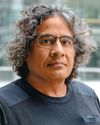
IN A NATION OBSESSED with baseball, basketball and American football, cricket has been like a stepchild, a non-starter, a mere question, "What is that?" While South Asians are one of the fastest growing segments of the American population, and there are many players from former Commonwealth countries, is the sport catching on with the mainstream?
Some white commentators in the media have written about attending the World Cup matches and they have marvelled about the carnival atmosphere, the lively music and the fact that the concession stands offer chicken tikka masala and samosas along with the standard hot dogs and popcorn. But, when it comes to finding avid white fans-or fans of any colour-who are besotted with cricket or play as a pro, it is like hunting for a needle in a haystack.
Bernard Bercik, a 16-year-old cricketer, has actually left his country in search of greener pastures. A true-blue American, he left because he was not getting anywhere in his quest. He has actually done a reverse American Dream migration to the Netherlands, where he plays for The Royal Den Haag cricket club.
Bernard is of Hungarian and Irish descent; his father was a colonel in the US army once deployed in Iraq and Afghanistan. His mother worked with the US navy. There is no cricket heritage in the family. "My father has never picked up a bat," says Bernard. "My mom has never picked up a bat. They did not even know what cricket was. They just cared about what their son cared about. They were willing to do anything to make me happy."
This story is from the {{IssueName}} edition of {{MagazineName}}.
Start your 7-day Magzter GOLD free trial to access thousands of curated premium stories, and 9,000+ magazines and newspapers.
Already a subscriber ? Sign In
This story is from the {{IssueName}} edition of {{MagazineName}}.
Start your 7-day Magzter GOLD free trial to access thousands of curated premium stories, and 9,000+ magazines and newspapers.
Already a subscriber? Sign In

Constipation Can Put Your Heart At Risk
PEOPLE WITH CONSTIPATION have an increased risk of major cardiac events, including heart attack, stroke and heart failure, especially if they also have high blood pressure, finds an international study published in the American Journal of Physiology-Heart and Circulatory Physiology.

Too Much Sitting Can Accelerate Ageing
SITTING FOR EXTENDED PERIODS can harm the heart and accelerate ageing, even if you are young and get the minimum recommended amount of daily exercise, according to a US study published in the journal PLOS One.

Efficiency and innovation
As health care evolves, professionals must employ innovative methods to refine their skills

Level up
Only 30 per cent of needy patients are able to undergo transplant in India; we need more dedicated transplant centres

HOPE STEMS FROM A CELL
While stem cell therapies have shown success in treating blood disorders, orthopaedic ailments, autoimmune diseases and eye issues, there is hope that they can one day treat patients with heart disease, blindness, Parkinson's, HIV, diabetes and spinal cord injuries

Mind matters
Your mindset can limit or expand your physical ability

Cutting edge
Would you go under the knife if a robot was the one holding it? Or would you say, \"No way, I need a human touch\"? You might have to decide soon because a robot that can imitate skilled human surgeons is already here.

The smallest cut
Minimally invasive surgeries have a bright future, with virtual reality and 3D procedures offering greater precision and AI on the horizon

Signalling a revolution
Canadian scientist and entrepreneur Sachdev Sidhu is focused on bringing cutting-edge antibody engineering to his country of origin

Wellness on demand
Starting as a doctor-patient chat platform, Medibuddy has evolved to be India's largest on-demand, full-stack digital health care platform